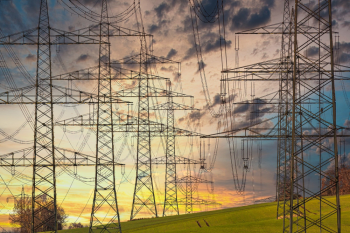Environmental impacts of the rollout of smart metering systems
This article is part 3 of 3 in the series of articles “Sustainability aspects in the decentralised and digital energy system”.
Series of articles on sustainability aspects in the decentralised and digital energy system
- Participative aspects in the smart energy system – between theory and practice
- Digitalisation and sustainability: (How) do they fit together?
- Environmental impacts of the rollout of smart metering systems
As already introduced in the previous parts of the series of articles, digitalisation is also becoming increasingly relevant in the context of the energy transition. With the Act on the Digitalisation of the Energy Transition (GDEW), the german legislator decided on the nationwide rollout of smart metering systems, iMSys for short. Details on the topic of iMSys can be found in the series of articles on smart metering. The functions of the iMSys are diverse – for example, new business models can emerge that promote the intelligent integration of decentralised systems such as photovoltaics, heat pumps or electric mobility into the energy system and offer new participatory opportunities for end consumers (see Part 1 of this series of articles). Through the resulting transparency of consumption data to end consumers, legislators also expect energy savings through the identification and replacement of inefficient equipment.
As explained in Part 2, the actual ecological added value of digitisation measures is influenced by numerous environmental effects, which can be divided into first-order and higher-order effects. In the course of the C/sells sub-project of the FfE, initial investigations of first-order effects have already been carried out by means of a life cycle analysis (LCA) based on ISO 14040/44 [1] of the iMSys infrastructure. In this series of articles, the results of a further study are presented, which records the environmental impacts of the infrastructure, including data transmission and storage, and presents a projection for the legally planned iMSys rollout. Detailed information on the methodology, the data and the results can be found in the publication “Environmental Assessment of Digital Infrastructure in Decentralized Smart Grids” (see [2]).
Environmental impacts of the smart meter infrastructure per “flexumer”
Based on the preliminary study, the LCA study is carried out for the use case of a flexibility call-off of a decentralised plant (e.g. photovoltaics) owned by a so-called “flexumer” (cf. [3]). First, an LCA is carried out for the components of the digital infrastructure. The functional unit includes the provision of flexibility of a flexumer household over one year (assumption: one flexibility call per day). The components include the iMSys, which is composed of a modern metering equipment (mME) and a smart meter gateway (SMGW). For the use case of intelligent control of decentralised systems, a control box is also balanced. As an extension to the preliminary analyses, in addition to the hardware components, the environmental impacts of data transmission and storage are also taken into account in the system boundaries of the LCA. In general, the scope of the data volumes depends on the tariff applications (TAF) of the use cases (for details see the series of articles on smart metering). The technical guideline TR-03109-1 of the German Federal Office for Information Security (BSI) currently defines 14 TAFs (as of 2020), which ensure standardised and secure data transmission of various use cases. For the use case of a flexibility call-off investigated in this study, TAF 7 and TAF 9 are relevant in combination with further process steps, including the establishment of a secure data communication channel and the switching of a flexibility option. In the course of the field test, analyses were carried out on the occurring data volume of different TAFs (cf. Technical analysis of the iMSys infrastructure). Daily measurement data combined with the process steps of a flexibility request (assumption: one flexibility call per day) cause a marginal total data volume of > 0.2 GB per year.
The results and sensitivity analyses on the annual climate impacts vary between 36 and 59 kg CO2 equivalents depending on the scenarios with different energy consumption and lifetime (n). In the medium scenario, these amount to 47 kg CO2 equivalents per flexumer annually (electricity mix 2020). With further decarbonisation of the emission factor for electricity procurement, this value can be reduced to a minimum of 27 kg CO2 equivalents in 2030. Figure 1 presents the results of the sensitivity analysis for defined scenarios on energy demand and lifetime (horizontal) and taking into account changes in the electricity emission factor over time (vertical).

Low effects due to data transmission and storage
By scaling up the results, an estimate of the direct environmental impacts of the large-scale rollout of smart meter infrastructure decided by the legislator can be determined. For this purpose, the rollout estimates for 2030 by the Federal Ministry are used, whereby an installed number of 15.4 million SMGWs is to be expected in the low-voltage level [4]. The extrapolation for further components (mME, control box) and the assumed data transmission is based on the classification of expected use cases according to [4].
As shown in Figure 2, the applied LCA approach results in a footprint of 513,679 t CO2 eq. (0.5 Mt) per year for smart meter infrastructure. This compares to total emissions from ICT in households in 2019 of approximately 10.8 Mt CO2-eq. and 13.7 Mt CO2-eq. in the commercial, trade and services (GHD) sector.[1]
As can be seen in the outer circle of Figure 2, 99 % of the calculated environmental impacts of the meter infrastructure are attributable to the operating phase (57 %) and the production phase (42 %) of the hardware components. As already concluded from the analysis results on the low data volume of a flexumer, the share of climate impacts due to data processing is marginal at < 0.2 %.

Possible (over-)compensation of life-cycle based emissions by higher order effects?
As presented in part 2 of this series of articles, for a holistic view of environmental impacts, the caused life-cycle-based footprint (“first-order effect”) must be compared with further associated environmental impacts (“higher-order effects”). As a possible positive effect, a current meta-analysis on energy efficiency through ICT in households shows potential energy consumption reductions of between 2 and 5 % through the provision of electricity consumption data to households (cf. [8]). Although the minimum necessary saving of 2.7 % to compensate for the calculated 47 kg CO2 eq. per Flexumer household and year is in this range, according to the study, medium- and long-term achievable savings through corresponding behavioural changes are associated with great uncertainties.
Digitalisation measures can also cause system-wide effects, in this case related to impacts in the energy system. In connection with the use of flexibilities in distribution grids, existing analyses such as [9] and [10] come to the conclusion that market-based flexibility mechanisms in distribution grids can lead to a higher integration of renewable energies with a simultaneous reduction of grid expansion measures. For example, an analysis of CO2 avoidance through flexibility use at distribution grid level (cf. [9]) concludes that a reduction of around 1.5 million tonnes of CO2 emissions could be achieved in 2035 by avoiding feed-in management (EinsMan) measures. Savings of this magnitude would put the footprint of smart infrastructure into perspective, but further research is needed.
Another positive contribution from intelligent flexibility measures relates to a potential reduction in conventional grid expansion. Due to the dependence on techno-economic framework conditions and other circumstances in the respective grid area, further methods are necessary for quantifying possible positive or negative environmental effects. These include, for example, simulations using energy system and grid models. The results can supplement existing life-cycle-based analyses in order to take higher-order effects into account.
Conclusion and outlook
An LCA study on the rollout of a digital infrastructure in the energy system shows that the associated environmental impacts mainly depend on the efficiency of the devices and the development of the emission factor of electricity consumption in the operating phase. Due to the low data volumes for the investigated use case of a Flexumer, data transmission and storage play a negligible role in the life cycle assessment.
Digitalisation enables further, innovative business models and solution concepts whose effects from an ecological perspective – positive as well as negative – go beyond the life-cycle-based emissions of the components and thus beyond the classic LCA approach. For example, initial studies already show great potential for achieving significant greenhouse gas savings through intelligent solution concepts in the decentralised energy system. In order to capture these system-wide impacts in an environmental assessment, extended LCA approaches are required. In the context of use cases in the intelligent energy system, this includes the inclusion of energy system analysis methods. Corresponding further studies are necessary and planned by FfE in the area of intelligent charging strategies for electromobility.
[1] Final energy consumption by ICT in households 76.5 PJ and 97.6 PJ in the tertiary sector [5]; emission factor electricity 506 g CO2-eq./kWh (calculated according to data from [6] and [7])
Literatur:
[1] DIN 14040 – Umweltmanagement – Ökobilanz – Grundsätze und Rahmenbedingungen (ISO 14040:2009) – Deutsche und Englische Fassung EN ISO 14040:2009. Berlin: DIN Deutsches Institut für Normung e. V., 2009.
[2] Wohlschlager, Daniela et al.: Environmental Assessment of Digital Infrastructure in Decentralized Smart Grids. Oshawa, ON, Canada: 9th International Conference on Smart Energy Grid Engineering (SEGE), 2021.
[3] Westphal, Egon Leo et al.: Flexumer als Gestalter der digitalen Energiezukunft – Eine Begriffseinordnung. In: Energiewirtschaftliche Tagesfragen 7/8. Berlin: Bayernwerk AG, Forschungsstelle für Energiewirtschaft e. V., 2019.
[4] Technische Eckpunkte für die Weiterentwicklung der Standards für die Digitalisierung der Energiewende – Entwurf Version 0.9. Berlin, Bonn: Bundesamt für Sicherheit in der Informationstechnik, 2021.Bundesministerium Energie: Energiedaten: Gesamtausgabe. In: https://www.bmwi.de/Redaktion/DE/Artikel/Energie/energiedaten-gesamtausgabe.html. (Abruf am 2020-07-20); Berlin: Bundesministerium fuer Wirtschaft und Energie, 2020.
[5] SMARD – Strommarktdaten: https://www.smard.de; Bonn: Bundesnetzagentur BNetzA, 2021.
[6] The ecoinvent Database, Version 3.6: www.ecoinvent.org; Zürich: ecoinvent, 2019.
[7] Bastida, Leire et al.: Exploring the role of ICT on houshold behavioral energy efficiency to mitigate global warming. Bizkaia: Renewable and Sustainable Energy Reviews, 2019.
[8] Geschermann, Kilian et al.: Evaluation of market-based flexibility provision for congestion management in distribution grids. In: 2017 IEEE Power & Energy Society General Meeting; Chicago, IL, USA: RWTH Aachen University, 2018.
[9] E-Bridge Consulting GmbH: Sichere und effiziente Koordinierung von Flexibilitäten imVerteilnetz. Bonn: E-Bridge Consulting GmbH, 2017.

